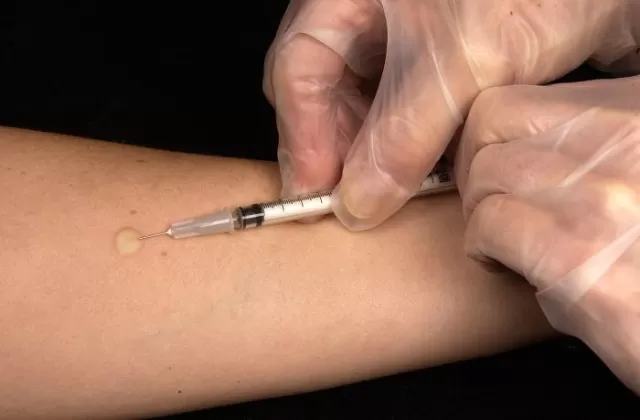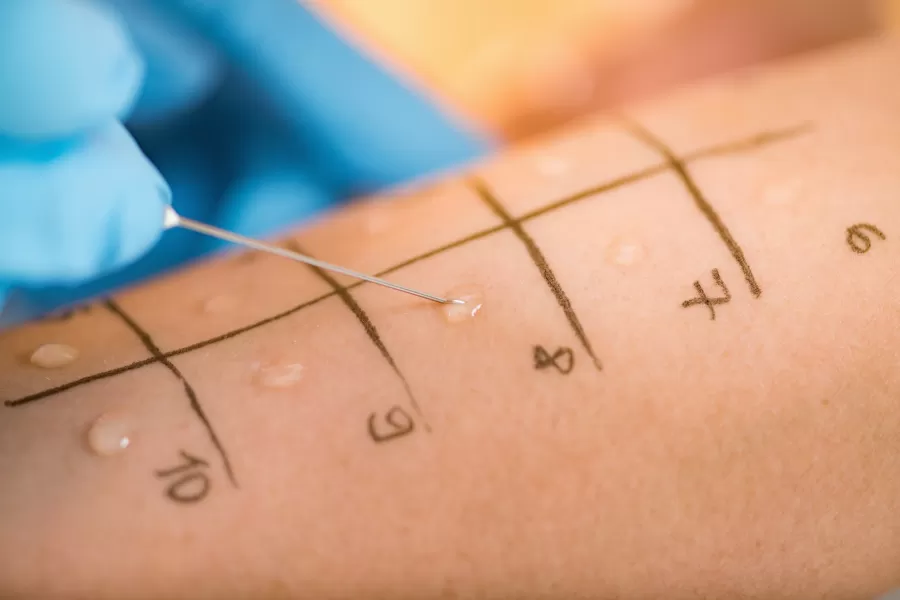-
ALLERGY IQ
Allergies and Health -

Children & Inhalant Allergies Allergies are a chronic disorder that starts early in life. It is one of the most common health conditions that affects one out of three children in the U.S. -

Oral Allergy Syndrome is Not Food Allergy Oral allergy syndrome (OAS) is often confused with food allergies but is not the same thing and is more common than people realize. -

Allergies & Poor Sleep Sleep is a huge factor in health and wellbeing. If your quality of sleep is affected by allergies, know that there are solutions. -

Hay Fever (Allergic Rhinitis) Unlike the common cold, hay fever is not caused by a virus. Instead, it’s caused by an allergic response to indoor/outdoor allergens like pollens, mold, mites.
-

How Allergies and Asthma are Related People who suffer from allergies can develop asthma and those with asthma can suffer from allergies. Both conditions are closely related. -

Allergy Load Find out why chronic allergic disease progresses with age, learn about Total Allergy Load, stressors, and why you don't want to delay allergy treatment.
Treating Allergies -

Managing Your Allergies Allergies are a serious burden on your immune system, not just runny nose, sneezing, and itchy eyes. Learn how to safely treat allergies for full-body health. -

Testing For Allergies: Is It Necessary? Allergy testing is a necessary step in treating symptoms of allergic rhinitis. Skin and blood tests can find the source and ideal treatment for your symptoms. -

Nasal Steroid Sprays Due to their high efficacy and safety, nasal steroid sprays are considered the first line of treatment for allergic rhinitis and other nasal conditions. -

Nasal Obstruction, Inhalant Allergies, and Turbinate Reduction Inhalant allergies can cause nasal obstruction and enlarged turbinates. Learn about the causes and treatment options for your chronic congestion.
-
- ALLERGY EXPLORER
- ALLERGY QUIZ
- SEARCH
- ACCOUNT
TESTING FOR ALLERGIES: IS IT NECESSARY?
Allergy testing is a crucial step in your journey to a life without symptoms. Even without a diagnosis, if people suffer from headaches, coughing, sleepless nights, or respiratory issues, they might be unknowingly dealing with allergies.
Anyone, regardless of allergy status, can benefit from safe, effective testing.
Why Is Allergy Testing Important?
Testing for allergies is the only way you can find the proper treatment for your triggers. Going through an allergy assessment allows an allergist to determine the particular irritant that causes symptoms. With that, they can develop a treatment plan and help you learn what environmental stressors to avoid.
Allergy treatments are most effective when patients know their stressors. For example, healthcare providers need to know which allergens cause symptoms in order to prescribe immunotherapy to boost immunity and reduce sensitivity. Similarly, other treatment options, like lifestyle changes only reduce symptoms when allergy professionals are armed with full knowledge about the patient’s irritants.
Regardless of the treatment option you choose, allergy testing is an essential step in the process. Until you know which allergens affect you, it is impossible to decrease your reaction enough to enjoy a symptom-free life.
How Does Allergy Testing Work?
Allergy testing is a comfortable, safe experience that thousands of people go through every day.
People who suffer from allergies have an overreaction to irritants, or allergens. The body produces Immunoglobulin E (IgE) antibodies that signal cells to produce an allergic reaction like sneezing, respiratory issues, or runny nose. This allergic reaction and inflammation is a defense mechanism - your body’s way of defending you from what it believes are dangerous irritants.
Allergy tests either measure the external reaction to an allergen or the presence of antibodies in a patient’s blood. Providers may recommend a particular test based on the patient’s medical history and experience with allergies.
In addition, prior knowledge of irritants is used to determine which allergens to test for. Geographical region is also a factor - if you live in an area known for a specific type of pollen, your allergist will add that to the test.
Let’s take a look at each testing option
Skin Testing
Skin tests are safe, easy, and accurate. They can detect allergic reactions to inhalants like dust and pollen, foods, drugs, and topical products. Prick and intradermal analysis are the most common forms of skin testing.
Prick Tests

Skin pricks are an allergy screening test used to determine if a patient is highly sensitive to specific allergens.
To perform the test, an allergist puts a drop of each diluted allergen onto the patient's arm or back with a grid system. The grid keeps track of each allergen's name and response. A very low concentration of the irritant is used, just enough to trigger a reaction.
Then, they give a slight prick, so the allergen extract goes into the surface of the skin. After the pricks, the patient will wait a few minutes, and the allergist checks back in to see if they've developed a skin reaction.
The reaction usually looks like a raised red bump, also known as a wheal - similar to a mosquito bite. Depending on the severity, the irritation will heal in a few minutes to a few hours. The allergist then analyzes the reaction based on the size of the wheal, measured in millimeters.
After examining, an allergist can determine that a patient is allergic to any irritants that caused a reaction, which is considered a positive test. An intradermal test is usually performed next for negative test or, allergens that didn't cause a reaction.
Before testing, the allergist assesses the patient's reaction to two other substances: glycerin and histamines. Glycerin is a "control" used to dilute the allergens, so patients are tested to ensure they do not react to it. On the other hand, histamines are a compound that should always cause a reaction. When patients are tested with histamines beforehand, the allergist can make sure their immune system responds normally.
Intradermal Testing

Intradermal testing is the most accurate type of allergen assessment. It’s as quick and easy as a prick test, but it has better detection of weak reactions. In other words, it can tell when your body has even a tiny response to an allergen.
To deliver this test, an allergist injects a diluted amount of each irritant into the patient's arm or back. Like with skin prick testing, patients wait in the office for around 20 minutes for the allergist to assess the reaction. In many cases, another, more potent dose of any allergens the patient did not react to is then administered. The second dose gives an even more thorough level of assessment.
IDT can be performed without prior allergy screening prick testing, but often is used in combination. A patient’s reaction to the skin prick test determines the correct concentration of allergens for the subsequent intradermal test.
Because the allergen is injected into the layer of skin rather than just a small prick, it’s more sensitive. That makes intradermal testing one of the best options, giving accurate results for even the most minor reactions. Only after completing an IDT with no reaction is an allergen considered “not an irritant.”
IDT is a crucial allergy test because it is used to diagnose inhalant allergies and measure a patient's progress in immunotherapy. Intradermal testing is used every 3 months during the buildup period to determine if the allergen concentration can be increased for the next immunotherapy treatment vial. That way, patients safely gain increased immunity to the allergen over time.
Skin Testing Children for Inhalant Allergies
Skin testing is still the best method of testing children for inhalant allergies. Children as young as two years of age can successfully be tested. Fortunately, a prescription topical anesthetic cream can be applied to “numb” the skin of the arms two hours prior to testing to minimize anxiety and prevent discomfort. Due to a smaller skin surface area in young children, prick and IDT may need to be done in two separate visits.
Blood Testing
In general, blood tests are more expensive for patients because they require lab work and take longer to produce results. They are also less sensitive and often miss many significant allergens that contribute to an allergy sufferer’s symptoms. However, in some cases, they are the preferred method. There are two types of blood tests for allergies: radioallergosorbent and enzyme-linked immunosorbent assay.
Radioallergosorbent (RAST)
In RAST tests, your blood is drawn and sent to a lab. Experts analyze the blood to determine if it produces IgE antibodies, the immune system's response to allergens, bacteria, and viruses. If IgE antibodies are present, you may be diagnosed with an allergy.
RAST testing is considered an older technology. The test has some disadvantages: there are higher rates of false positives, and it is much less sensitive than skin tests. Additionally, these tests use a mixture of allergens, so they do not always indicate if the patient is allergic to a specific irritant.
Enzyme-Linked Immunosorbent Assay (ELISA)
A newer, more accurate blood test is the ELISA test. Though the name might sound overwhelming, the test itself is not - it’s a simple blood draw that’s later sent to a lab. This assessment checks for allergen protein molecules present in the blood.
ELISA is mainly used to detect food allergies rather than inhalants, so it doesn't always help to diagnose common environmental allergies. However, it is also used to test for the presence of allergens in foods, so it’s a valuable test to prevent reactions in the food industry.
Benefits of Each Type of Allergy Test
Skin Prick
- Skin is “pricked” with allergens
- Effective as a screening test for allergies
- Needs additional testing to confirm negative result
Intradermal (IDT)
- A small amount of allergen is injected into the top layer of skin
- Most accurate
Radioallergosorbent (RAST) Blood IgE
- Blood is drawn and sent to the lab for analysis
- Tests for fewer allergens
- Less accurate
Enzyme-Linked Immunosorbent Assay (ELISA)
- Useful for detecting food allergies
- Most accurate type of blood test
Should You Get Allergy Testing?
These tests might seem intimidating, especially if you’re recently learning about allergies. But thousands of adults and children go through safe allergy testing each day.
It’s important to talk with your doctor to determine the right test for you. Most insurance plans cover allergy testing, including skin prick, IDT, and blood tests, so the cost doesn’t have to be a deterrent.
New testing technology allows us to identify allergens with just a little prick or injection. And with that information, you can learn about the right treatments and start to live a clear, allergy-free life.
You can learn more about potential triggers and find a test and treatment that’s right for you here at Clear Allergies.
Resources
- American Academy of Allergy, Asthma, & Immunology: Immunoglobulin E (IgE) Defined
- World Allergy Organization: Allergy Diagnostic Testing
- Australian Society of Clinical Immunology and Allergy: Laboratory Investigation of Allergic Diseases
- University of Rochester Medical Center: Diagnostic Tests for Allergies
